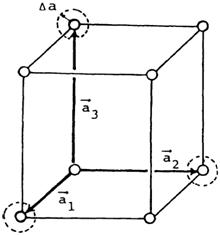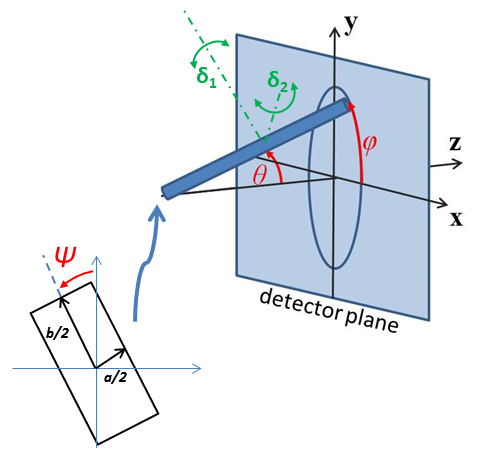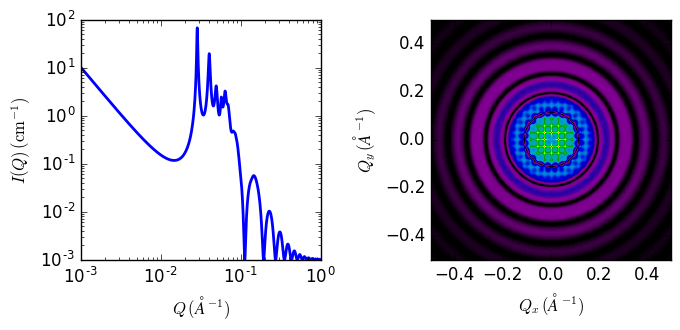sc_paracrystal
Simple cubic lattice with paracrystalline distortion
| Parameter | Description | Units | Default value |
|---|---|---|---|
| scale | Source intensity | None | 1 |
| background | Source background | cm-1 | 0.001 |
| dnn | Nearest neighbor distance | Å | 220 |
| d_factor | Paracrystal distortion factor | None | 0.06 |
| radius | Radius of sphere | Å | 40 |
| sld | Sphere scattering length density | 10-6Å-2 | 3 |
| sld_solvent | Solvent scattering length density | 10-6Å-2 | 6.3 |
| theta | c axis to beam angle | degree | 0 |
| phi | rotation about beam | degree | 0 |
| psi | rotation about c axis | degree | 0 |
The returned value is scaled to units of cm-1 sr-1, absolute scale.
Warning
This model and this model description are under review following concerns raised by SasView users. If you need to use this model, please email help@sasview.org for the latest situation. The SasView Developers. September 2018.
Definition
Calculates the scattering from a simple cubic lattice with paracrystalline distortion. Thermal vibrations are considered to be negligible, and the size of the paracrystal is infinitely large. Paracrystalline distortion is assumed to be isotropic and characterized by a Gaussian distribution.
The scattering intensity \(I(q)\) is calculated as
where scale is the volume fraction of spheres, \(V_p\) is the volume of the primary particle, \(V_\text{lattice}\) is a volume correction for the crystal structure, \(P(q)\) is the form factor of the sphere (normalized), and \(Z(q)\) is the paracrystalline structure factor for a simple cubic structure.
Equation (16) of the 1987 reference[1] is used to calculate \(Z(q)\), using equations (13)-(15) from the 1987 paper[1] for \(Z1\), \(Z2\), and \(Z3\).
The lattice correction (the occupied volume of the lattice) for a simple cubic structure of particles of radius R and nearest neighbor separation D is
The distortion factor (one standard deviation) of the paracrystal is included in the calculation of \(Z(q)\)
where g is a fractional distortion based on the nearest neighbor distance.
The simple cubic lattice is

For a crystal, diffraction peaks appear at reduced q-values given by
where for a simple cubic lattice any h, k, l are allowed and none are forbidden. Thus the peak positions correspond to (just the first 5)
Note
The calculation of Z(q) is a double numerical integral that must be carried out with a high density of points to properly capture the sharp peaks of the paracrystalline scattering. So be warned that the calculation is slow. Fitting of any experimental data must be resolution smeared for any meaningful fit. This makes a triple integral which may be very slow.
The 2D (Anisotropic model) is based on the reference below where I(q) is approximated for 1d scattering. Thus the scattering pattern for 2D may not be accurate particularly at low \(q\). For general details of the calculation and angular dispersions for oriented particles see Oriented particles . Note that we are not responsible for any incorrectness of the 2D model computation.

Fig. 57 Orientation of the crystal with respect to the scattering plane, when \(\theta = \phi = 0\) the \(c\) axis is along the beam direction (the \(z\) axis).

Fig. 58 1D and 2D plots corresponding to the default parameters of the model.
Reference
| [1] | (1, 2) Hideki Matsuoka et. al. Physical Review B, 36 (1987) 1754-1765 (Original Paper) |
| [2] | Hideki Matsuoka et. al. Physical Review B, 41 (1990) 3854 -3856 (Corrections to FCC and BCC lattice structure calculation) |
Authorship and Verification
- Author: NIST IGOR/DANSE Date: pre 2010
- Last Modified by: Paul Butler Date: September 29, 2016
- Last Reviewed by: Richard Heenan Date: March 21, 2016